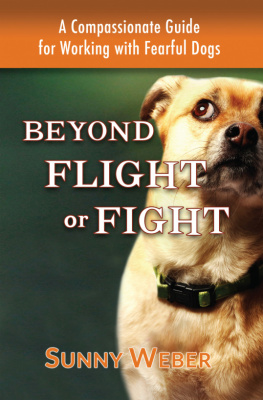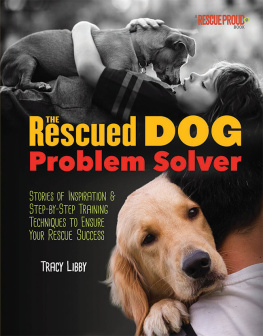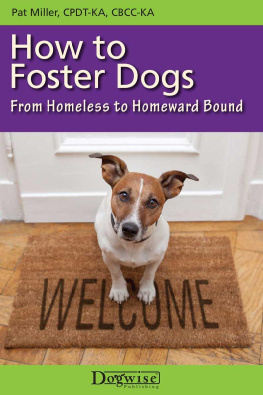Rescue Your Dog
from Fear
Tried-and-True Techniques to
Help Your Dog Feel Secure
PEGGY O . SWAGER

Guilford, Connecticut

An imprint of Rowman & Littlefield
Distributed by NATIONAL BOOK NETWORK
Copyright 2015 by Peggy O. Swager
All rights reserved. No part of this book may be reproduced or transmitted in any form by any means, electronic or mechanical, including information storage and retrieval systems, without written permission from the publisher, except by a reviewer who may quote passages in a review.
British Library Cataloguing-in-Publication information available
Library of Congress Cataloging-in-Publication data available
ISBN 978-1-4930-0477-5 (paperback)
ISBN 978-1-4930-1634-1 (e-book)
 The paper used in this publication meets the minimum requirements of American National Standard for Information SciencesPermanence of Paper for Printed Library Materials, ANSI/NISO Z39.481992.
The paper used in this publication meets the minimum requirements of American National Standard for Information SciencesPermanence of Paper for Printed Library Materials, ANSI/NISO Z39.481992.
This book is dedicated to my mother who put up with me working with so many pets when I was young.
To my husband who has helped me work with so many dogs, even though he sometimes got bit, and to my daughter and son, Tia Reinschmidt and Scott Olson.
They both are good dog trainers in their own right and have helped me reform some of my problematic dogs.
CONTENTS
INTRODUCTION
Hes here in my lap as we speak, and I think he knows youve called, Jina told me when I rang her to get an update on Albert. The long-haired Chihuahua now owns Jina. I knew hed be the one to own her and not the other way around. Theyd hit it off when she came to meet my foster dog, as if they were destined to be together. Jina then told me about teatime, where Alberts tail spins like a helicopter as she takes down his cup and places a bone in it. Hed then politely follow her to the table and join her and her son for the tea ceremony. No wonder they gave him the nickname Sir Albert.
For many people, this kind of cute behavior in a dog is coveted. Seeing Albert now, it may be hard to envision his life before. Two years earlier, Albert was a highly fearful dog living in a mill dog rescue. After spending a year at the facility, even though the dog was on anxiety medication, the rescue worried he would be unadoptable. When I first took on Albert as a foster dog, he was so fearful that hed curl up into a ball and go into a catatonic state when people tried to interact with him. When he came out of that highly fearful state, sometimes hed bite.
With the right techniques, Albert was able to transform from a mill dog to a regular dog.
Otis was another dog at the mill dog rescue I fostered because he wasnt able to transition from the mill dog environment to a regular home without help. He is now a confident dog. I remember when I took him to a friends house whose father was in a wheelchair. Otis went up to the guy with his tail wagging as if he was a therapy dog.
Ive had the privilege of helping out a lot of fearful and highly fearful dogs. Some were mill dog rescues, some came from regular rescues, and others were pets owned by people for years. Nothing is more rewarding than to see these dogs go from timid to enjoying their lives like any other dog.
Albert is a dog who illustrates that you can rescue your dog from fear, even if he was raised breaking all the rules for developing security in a dog. Up until four years of age, Albert lived in constant fear, especially when it came to interacting with people. Yet he recovered from his fear issues. This book works to give all dog owners the tools they need to help their dog feel safe and secure. Issues from house-training regression to submissive peeing are covered extensively. Dog owners who have pets with fear issues will learn about mistakes they may be making that can contribute to their dogs lack of security. Becoming your dogs fear advocate can help your dog learn to trust you and keep the dog out of harmful situations.
Fearful dogs need confidence to become less fearful. Ways to do that include establishing a foundation of security in your dog, finding out how to be a dependable leader to your dog, and learning the best possible techniques for desensitizing the dog. The firsthand stories of successes with reforming fearful dogs will not only present solutions for people with similar issues, but can also give hope to all dog owners.
CHAPTER 1
Where Do Fearful Dogs Come From?
Although, in essence, fear is a healthy reaction to the threat of danger, some people are having issues because the dog is reacting to a nonthreatening situation or the dog is overreacting. If your dog is too often or too intensely afraid of too many things, you have a problem that needs to be fixed. Overly fearful dogs may be afraid of most people, other dogs, things, noises, or places. These dogs can be skittish on walks and may react to noises other dogs ignore. Dogs with fear issues may hide from people coming over to your house. The same dog may panic if you leave its side, making the dog more prone to separation anxiety. Excessive fearfulness in dogs can result in behavior issues from house-training problems to aggression. Without the right kind of intervention, a dogs fearfulness and insecurity can grow. A good place to begin to help a dog with fear issues is to learn where fear in dogs comes from.
FEARFULNESS IN DOGS
There are a multitude of reasons why you see fearfulness in dogs. Certain base personalities in dogs can pose more of a challenge to a dogs sense of security, including shyness, a reserved nature, and a highly sensitive nature. Under-socializing a dog can generate a fearful animal. Dogs with more challenging personalities or behavior problems due to fear are at a greater risk of being surrendered as a rescue. Unfortunately, most dogs find a rescue environment stressful, creating fear in dogs who didnt previously have issues and compounding fear in those who did. Some fearful dogs are created when we misunderstand or mis-communicate with them when asking for compliance, especially if harsh training techniques are used.
Talking Terms
Often, we interchange the words shyness and fearfulness. We often describe fearful dogs as acting shy. Below are some working definitions of those terms.
Fear: the emotion experienced in the presence or threat of danger. Fear is a vital response to physical and emotional danger.
Fearfulness: feeling or inclined to feel anxiety or apprehension; timid; nervous.
Shyness: fearful shyness typically begins when the animal is young. Shyness involves being frightened in social situations or being frightened when with others. The feeling of apprehension can range from mild to extreme.
WHERE FEARFUL OR SHY DOGS COME FROM
Dogs who are shy by nature, or have a reserved nature, are prone to becoming fearful and will require specialized training and handling to counter that issue. Another trait that can cause or add to fear issues is a highly sensitive nature. A highly sensitive dog may become uncertain about various stimuli such as loud noises or even people sneezing. These dogs can remain fearful if they are not helped to understand their environment. A soft dog is a dog who seems to take sensitivity to an extreme. These dogs become very uncomfortable with direct eye contact and often find verbal reprimands too harsh.









 The paper used in this publication meets the minimum requirements of American National Standard for Information SciencesPermanence of Paper for Printed Library Materials, ANSI/NISO Z39.481992.
The paper used in this publication meets the minimum requirements of American National Standard for Information SciencesPermanence of Paper for Printed Library Materials, ANSI/NISO Z39.481992.